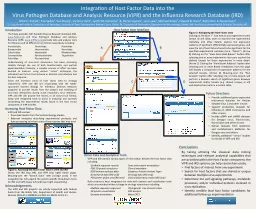

Virus Pathogen Database and Analysis Resource ViPR and the Influenza Research Database IRD Brett E Pickett 1 Eva Sadat 2 Yun Zhang 1 Victoria Hunt 1 Jyothi M Noronha ID: 913329
Download Presentation The PPT/PDF document "Integration of Host Factor Data into the" is the property of its rightful owner. Permission is granted to download and print the materials on this web site for personal, non-commercial use only, and to display it on your personal computer provided you do not modify the materials and that you retain all copyright notices contained in the materials. By downloading content from our website, you accept the terms of this agreement.
Slide1
Integration of Host Factor Data into the
Virus Pathogen Database and Analysis Resource (
ViPR) and the Influenza Research Database (IRD)Brett E. Pickett1, Eva Sadat2, Yun Zhang1, Victoria Hunt1, Jyothi M. Noronha1, R. Burke Squires1, Lynn Law3, Michael Katze3, Edward B. Klem4, Richard H. Scheuermann11J. Craig Venter Institute, 2Department of Pathology, University of Texas Southwestern Medical Center, Dallas, TX, 3University of Washington, Department of Microbiology, Seattle, WA. Northrop Grumman Health Solutions, Rockville, MD.
Accessing Host Factor Data
ViPR
and IRD contain:Processed results from the Systems Biology studiesRelevant metadata describing experimental protocols and data processing to inform users of any nuances that may exist
Acknowledgements
The
ViPR and IRD projects are wholly supported with federal funds from the NIAID, NIH, Department of Health and Human Services (N01-A1-12008038 and N01-A1-40041 to R.H.S.).
Conclusions
By taking utilizing the classical data mining techniques and relevant analytical capabilities that are provided within the Host Factor component, the
ViPR and IRD systems can help researchers easily:Find factors of interest from any experimentSearch for host factors that are shared or unique between multiple virus experimentsDetermine the cell signaling pathways, metabolic processes, and/or individual proteins involved in virus replicationIdentify credible lead host factor candidates for additional follow-up experimentation
Introduction
The
freely-available, NIH-funded Influenza Research Database (IRD, www.fludb.org) and Virus Pathogen Database and Analysis Resource (ViPR, www.ViPRbrc.org) provide data and analysis tools for Influenza and 14 different virus families respectively including: Arenaviridae Flaviviridae PoxviridaeBunyaviridae Herpesviridae ReoviridaeCaliciviridae Hepeviridae RhabdoviridaeCoronaviridae Paramyxoviridae Togaviridae Filoviridae PicornaviridaeUnderstanding of virus-host interactions has been increasing steadily through the use of both bioinformatics and wet-lab experimentation. Recently, a sizeable amount of effort has been devoted to measure, using various “-omics” techniques, the individual host factors that enhance or diminish viral infection and the host response. Given the immense value of host factor data to virology researchers, ViPR and IRD are cooperating with the NIAID-sponsored Systems Biology for Infectious Diseases Research programs to provide results from the analysis and modeling of virus-host interactions during acute respiratory virus infections. ViPR and IRD will provide the results, in an easy-to-use format, along with integrated tools to assist in analyzing and correctly interpreting the experimental results found in the Host Factor component of ViPR and IRD.
Future
Directions
Provide additional gene expression microarray datasets for Herpes Simplex Virus 1 and other virusesSupport proteomics datasets for Influenza A, SARS Coronavirus and other virusesInclude siRNA and shRNA datasets for Dengue virus, Flaviviruses, Noroviruses and other virusesDeliver datasets from lipidomics and metabolomics platforms for Dengue virus and othersIdentify additional “-omics” studies to include in ViPR and IRD
Other Data and Analytical Tools
ViPR
and IRD contain
various types of information besides the host factor data including: GenBank sequence records Gene and protein annotations PDB 3D protein structures Clinical metadata IEDB Immune epitope data Sequence Feature Variant Types Surveillance data (IRD only) Serology data (IRD only) PCR primer-probe sets (IRD only) Clinical laboratory results (IRD only)Both resources have integrated the data with analysis and visualization tools which are provided without charge to virology researchers including: Multiple sequence alignment Phylogenetic tree reconstruction 3D protein visualization SNP analysis Genome annotation Meta-CATS
Figure
1: Accessing the Host Factor Data in
ViPR
and IRD
Shows the IRD
(top
left)
and
ViPR (top right) home pages. Mousing-over the “Search Data” item (orange ovals) in the navigation bar will expand the system-specific drop-down menu for IRD and ViPR (lower left and lower right respectively).
Figure 2: Navigating the Host Factor DataClicking on the blue “i” icon next to any experiment name (arrow A) will allow users to examine the experimental metadata and other details, explore the expression patterns of significant differentially-expressed genes, and view the list of host factors found to be significant for the specified experimental variables (a.k.a. “bioset”). (Arrow B) Clicking on the “View Associated Biosets” button after selecting one or more experiments lets users explore the defined biosets for those experiments in more detail. (Arrow C) Clicking the “View Bioset Patterns” button after selecting one or more Bioset checkboxes from this page will display a comparison of expression patterns for the selected biosets. (Arrow D) Mousing-over the “Run Analysis” button after selecting one or more biosets will perform a Boolean search of significant genes between experiments and/or biosets (e.g. shared, unique, or all) and display the results in a custom table.
A
B
C
D
Host Factor User Interface